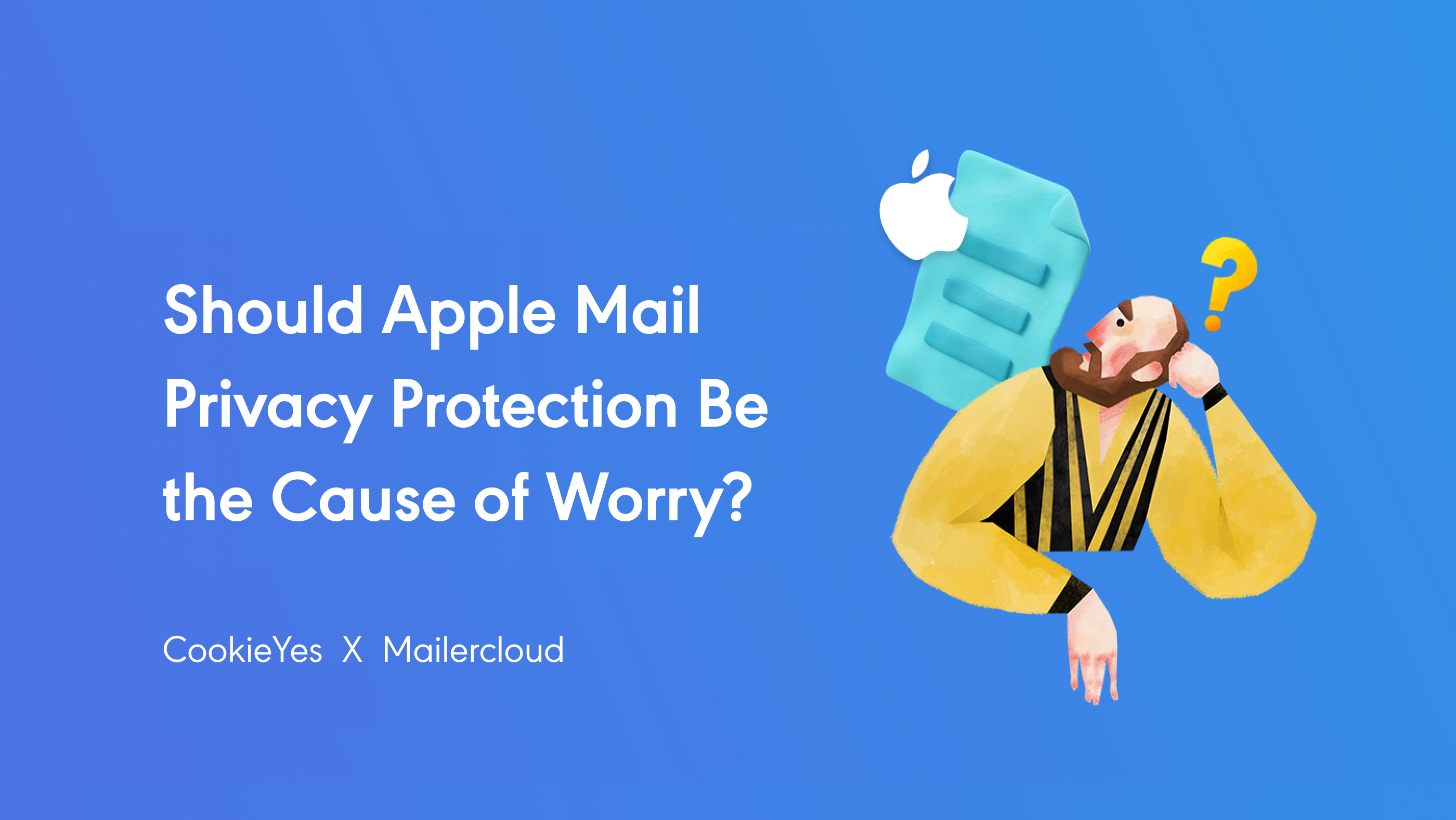The world of email marketing crumbled with the recent introduction of Apple’s new Mail Privacy Protection Policy for the Apple Mail app. This policy has unveiled new capabilities to let consumers better monitor and control how apps use their information, including the ability to block email tracking in the Apple Mail app. This news has caused a stir amongst the email marketers prompting them to question the efficacy of email marketing.
The announcement has undoubtedly had email senders talking about the potential consequences of these new policies on how they track and measure email marketing campaigns. However, the new policy changes will only impact the emails read through the Mail app on Apple devices and not the emails viewed through the Gmail app on Apple devices. Nonetheless, it’s worth the effort to learn about the changes irrespective of the fact that these changes in the policy aren’t particular to any email marketing tool.
The gist of Apple Privacy Policy
Apple’s Mail Privacy Protection Policy intends to safeguard the users’ privacy by keeping away the email senders from discovering about the user’s Mail activities. The policy provides the users with an opt-in option to hide from the sender whether or not they have opened the marketing emails.
The new policy and its features allow email recipients to keep email senders in the dark about when they open an email and conceal their IP address. Consequently, ceasing the email senders from linking the user’s IP addresses to their other online activities or using them to track their geographical location.
What should marketers be aware of?
The Apple Mail Privacy Protection policy prevents email senders and marketers, including Apple, from discovering about their recipient’s Mail activities. No entity will be able to recognize both the recipient and the Mail content they receive this way. Senders are unable to utilize the user’s IP address as a unique code to link their activities across websites or apps in order to create a database about the user.
The impact of Apple Privacy Policy on email marketing campaigns
Apple Mail forms a major part of any email marketing campaign’s target domain. It is a widely used email client with around 52% of emails being opened on Apple devices in the year 2021.
A big blow on the email open rates
Email open rates are a key metric for the success of email marketing campaigns as it sets the stage for further progress. The introduction of Apple’s new privacy policy will make email marketers unable to get a clear picture of the email open rates. Furthermore, they will not be able to retrieve insights on the email recipient’s location-based information.
When a user opts-in for the Mail Privacy Protection, then the email sent to their Apple Mail will be shown open, even if they take no notice of it. Automatic opens, on the other hand, will have an impact on email tracking and performance assessment, as well as the campaigns that utilize email opens as a filter or trigger. Though the email marketers will witness an increase in the email open rates, the data will no longer be that reliable.
Click-to-open rates may dwindle
The click-to-open rate (CTOR) relates the number of unique clicks to the number of unique email opens. Because the click-to-open rate is a corollary of the email open rate, Apple’s latest privacy policy changes deceptively lower the CTOR, making it an unreliable statistic in the future. But there’s a snag!
The Mail Privacy Protection has zero impact on the overall number of clicks. Because it merely indicates the total number of email recipients who clicked a link in the email, clicks remain a trustworthy approach to evaluate the performance of an email marketing campaign.
Does the Privacy Policy really affect the platform of email access?
The Apple Mail Privacy Policy restricts access to critical email campaign performance metrics and data. Correspondingly, this will restrict access to some of the email marketing features that rely upon this data, thus, making them less reliable.
List segmentation
Email open rates and the data about users’ demographics form the basis of creating email list segments. But with the Mail Privacy Policy in situ, reliable segregation of contacts as per their engagement, behaviour, demography and other parameters is not attainable.
Email automation
Some automatic email marketing campaigns send out emails on the basis of whether or not a subscriber opens the previous email. This is no longer an efficient technique to set up your email automation series because Apple Mail reports a false open for certain subscribers and sends the following email regardless of whether or not the user reads the previous email.
Rather, contemplate using an email click as a prompt for the automated email series. Not to forget that the Apple Mail policy may not affect some automated email campaigns, such as the welcome email or other payment reminder series.
A/B testing
Since the Apple Mail policy makes email open rates uncertain, A/B testing for subject lines has become unreliable as well. Without correct open rates, there will almost certainly be no accurate subject line testing – or any other type of test that relies on open rates as a determining factor.
Email list cleaning
Apple Mail customers will not be able to segregate their email lists depending on email open rates. This implies email marketers won’t be capable of leveraging email hygiene tactics based on open rates to keep their lists clean free of any stale or obsolete email contacts.
Email personalization on a real-time basis
Email personalization is not going away with the coming of Apple Mail Policy, however, some of its facets will change. Some email marketers employ dynamic email content that changes based on the recipient’s location when they open the emails. This sort of communication makes use of location tracking, which Apple Mail users will no longer be able to access. However, most forms of email marketing personalization still remain unaffected with the introduction of the Apple Mail Policy – like offering content based on the recipient’s interests, preferences, purchase behaviour, and so on.
What’s the response of the email marketing platform?
Privacy and data security is a major concern in all digital platforms including emails. And there’s no doubt that the emphasis on protecting these two will persist in the near future. The Apple Mail Privacy Protection has just attested to this fact.
Having a privacy policy in place for your website will help in complying with international regulations and other ethical standards. Likewise, a cookie consent banner and cookie policy with clear information are also important to inform the users about the trackers present on your website.
In fact, a little assistance will help create the privacy and cookie policy in a hassle-free manner. For instance, CookieYes privacy policy generator and cookie policy generator are some tools that comply with rules such as GDPR regulation, and that can secure the right policy for your website.
On the other hand, email service providers (ESPs) like Mailercloud are finding newer means to understand and handle the issues pertaining to metrics and analytics; and that also includes subscribers and lifetime values.
What’s next? Time to prepare yourself!
Apple Mail privacy reforms are almost definitely not the ultimate or penultimate point. Indeed, you can expect other technology bigwigs to follow Apple’s footsteps in safeguarding user data. It’s better to view this shift as a lucky break to evaluate what counts the most to you in terms of email marketing and to concentrate on those objectives.
Going forth, it’s time to start considering metrics other than just the email open rates to gauge the success of your email campaign. These metrics can be the email delivery rates and click-through rates. Start experimenting with your email list to see what succeeds and what doesn’t – what motivates the email recipients to click or what kind of content engages them the most?
Keep an even closer eye on the email deliverability and list cleanliness. Surveil your reputation and use email verification tools to ensure email list quality. Choose a professional email marketing tool with competent email deliverability expertise to ensure that your emails land in the subscriber’s inbox and not in the spam box.
Besides that, having in place an up-to-date cookie policy on your website is a great idea, as it is both a legal necessity and a customer demand. It’s an important aspect of establishing long-term, trustworthy customer relationships.



